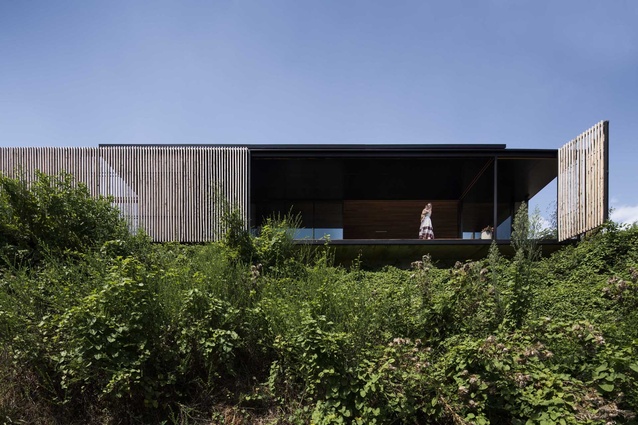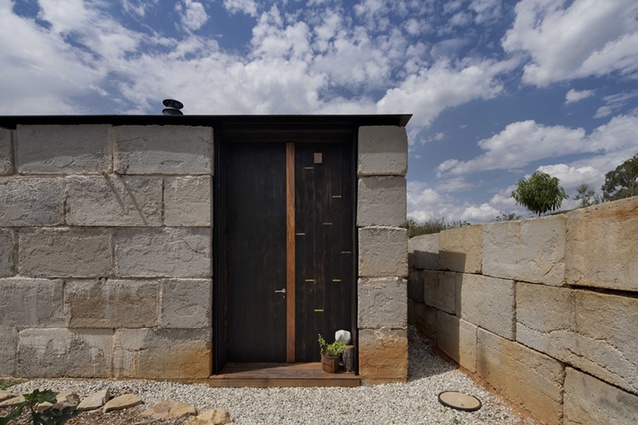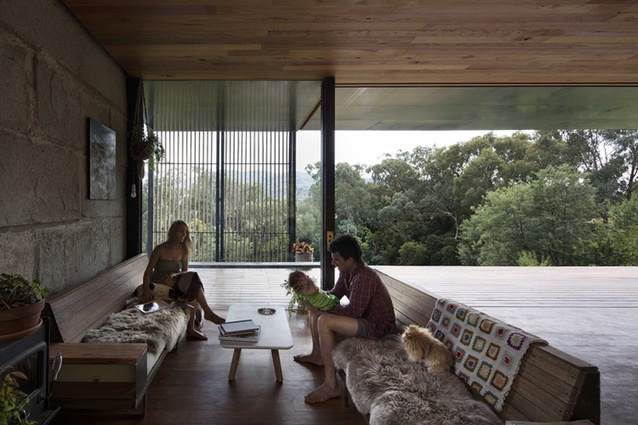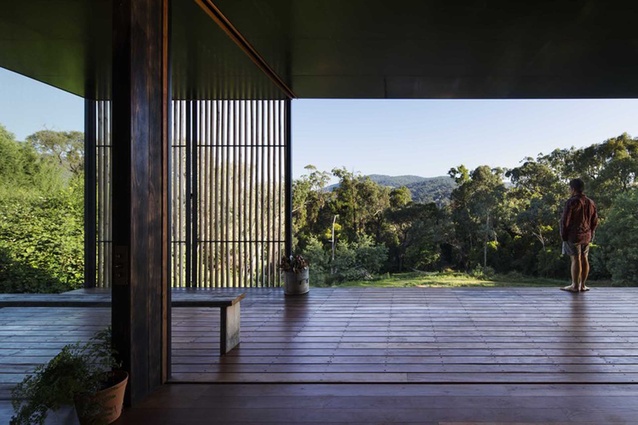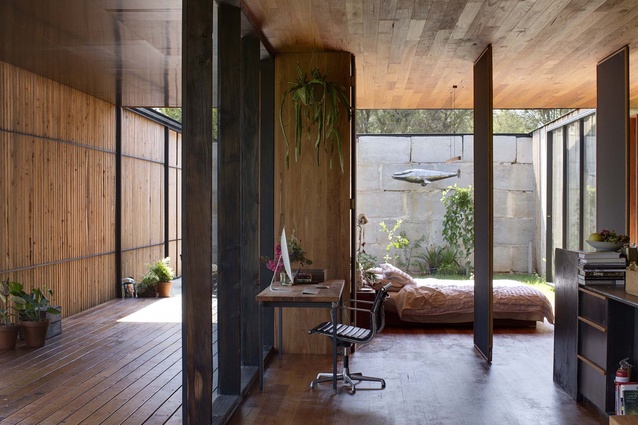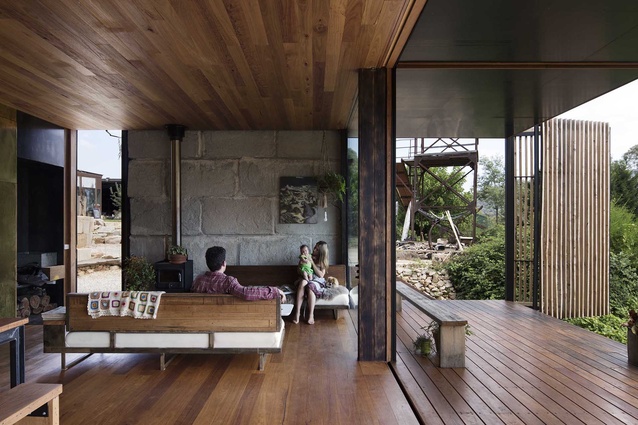Striking it rich
The omnipresent word ‘organic’ has almost become cliché. But the Sawmill House by Archier Studio truly warrants the description. In terms of process and materials, the house embodies a story of relationships, of serendipitous discovery, shared creative vision and of open-ended imagination.
It begins with two brothers – architect Chris Gilbert, and his brother Ben, a sculptor – and the site of a former sawmill, which at one time was a gold mine. The house overlooks a pond, on a flat pad that had been the spot where logging trucks would park during loading. Though zoned as an ‘industrial site’, Ben defined his intended one-bedroom residential structure as a ‘caretaker’s cottage’ and building permission was granted.
A rough plan was in place prior to the start of construction, but the design truly evolved over time. Chris says of the home in rural Victoria, Australia: “We kind of made it up as we went along. We had about five pages of drawings, and that was it.”
Freed from the traditional restraints, and liberated by the added bonus of being able to change and develop the design over the course of construction, the result is a highly functional home, full of bespoke elements that have their roots in pragmatic problem-solving, but are imbued with a substantial dash of ‘why not?’ bravado.
The home’s most striking feature – the 270 massive concrete blocks that comprise the exterior walls – is a prime example.

Chris Gilbert explains, “I was driving up near there one afternoon and went by a farm, and they were using these big blocks as a retaining wall and a dam. I thought ‘Wow – those really look cool’. So I found out where they came from (a quarry and concrete plant in nearby Wadonga) and I went there and asked if I could have them.”
The blocks weigh in at one tonne each and are produced locally as the by-product of the many residential slabs poured in the vicinity. The slabs vary in colour and size; and although this unpredictability adds to the external appeal, grounding the house to the site. Their different colours and textures create a stacked layer effect that echoes the site’s mining heritage.
“It was clear pretty early on that this wasn’t going to be a typical wall of brick, or concrete blocks, where everything fits together perfectly. We just stacked them into place as they came. There were just a few places where we needed to cut them because we needed a straight edge.”
Embracing the imperfection of unusual materials carries through to the inside, too. The centerpiece of the open-plan public area is a fully-integrated kitchen that runs along the main interior wall. Here, too, the typical cabinetry choices were discussed and discarded.
“We knew that whatever we used had to relate to the exterior. So we were just talking and trying to figure it out…and it was like, ‘timber would be too dark, and a laminate would be horrible… ’ and I said, ‘we could use a metal, like brass sheets or something… ’ and that was it.”
Brass sheets, 0.3mm thick, were a remarkably cost-effective solution, and complement the surrounding warm stone and timber elements.
“We’ve sprayed them with cider vinegar to start the patina, and day-to-day living does the rest. People touch them, the air and humidity have an effect; they just keep getting better.”
Throughout the interior, bespoke furniture and custom lighting elements – many created by Ben Gilbert, others by the team at Archier Studio – add to the overall artisanal effect. Among the most notable handmade items are the large dividers – some slide, some pivot – that enable the larger open-plan space to be subdivided according to use, and open or closed to the outdoors, depending on the weather.
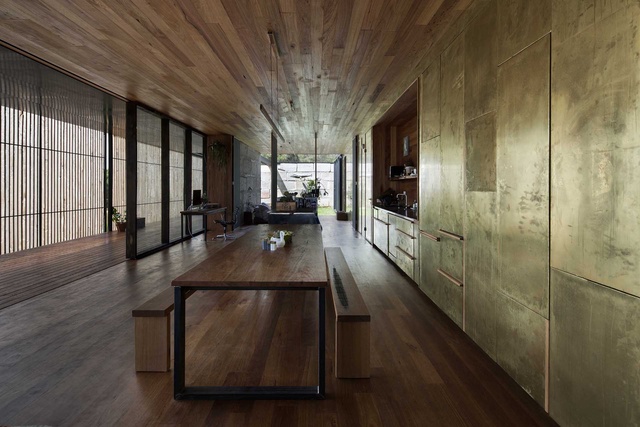
Above and below, long planes of locally sourced and reclaimed timber bring an element of softness and warmth, in contrast to the metal and stone. The floor continues seamlessly onto the wide deck, which cantilevers slightly out over the hill. Thanks to the expansive glass wall – double-glazed stacking doors – the view can be seen from the kitchen and living rooms throughout the year. A long timber screen can be moved along the far edge of the deck, bringing shade, as needed, during the day.
Large sections of the roof and façade are mechanised and moveable, which makes the envelope largely operable, allowing courtyards and natural light to be added and subtracted as the seasons warrant. The 60mm-thick blocks absorb sun during the day, but keep the interior cool. In the summertime, the sliding glass doors can be recessed back, opening up the sides of the building to cross-breezes. In the winter, just the opposite – opening the skylight allows sunlight to penetrate and warm the interior, while closing the stacking doors keeps the warm air inside.
The Sawmill House is receiving an increasing amount of local and international attention and has garnered a raft of awards for itself and its makers, including the 2015 Houses Award for New House under 200m2 (Australia). For the members of Archier Studio, it’s been a banner year. Chris Gilbert says: “It’s been incredible – massive, really – and it’s great because it shows the potential of smaller studios like ourselves, and the amazing results you can get from this kind of project. I feel like it’s been the right project, with the right people, at the right time.”

